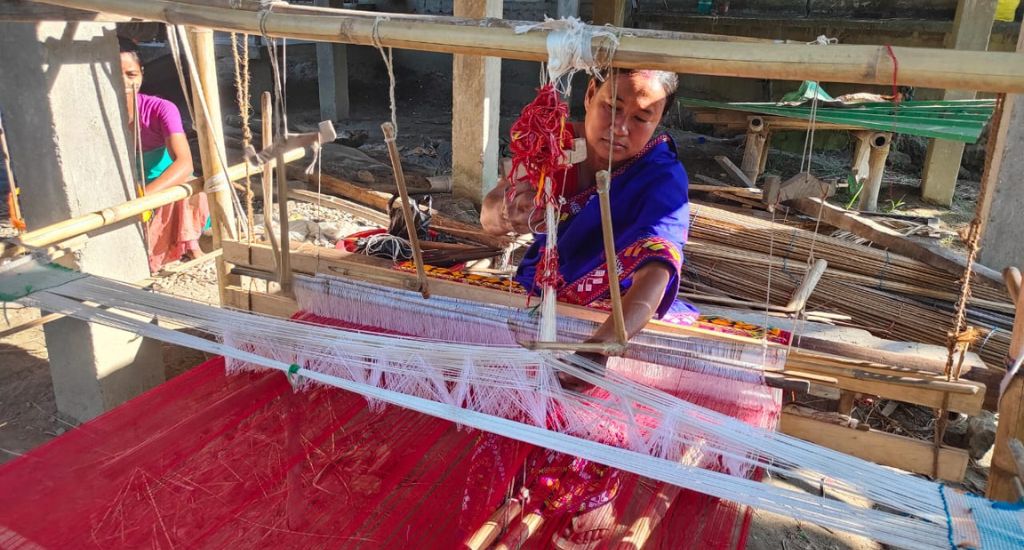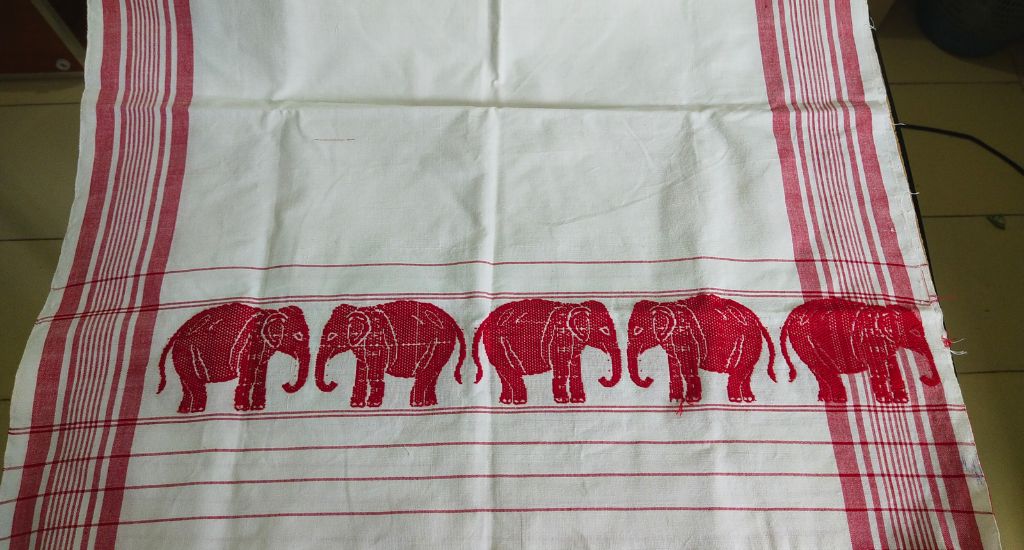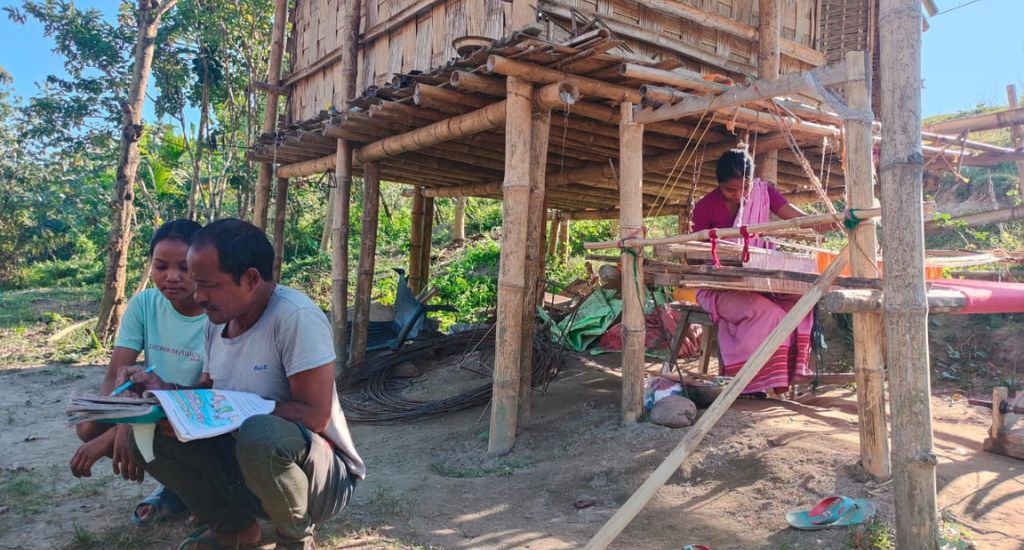
An elephant on the loom in river island Majuli
Battered by crop depredation and low farm yield, Majuli’s weavers grasp the loom of opportunity, creating not just garments but a narrative woven with threads of hope and transformation.

Battered by crop depredation and low farm yield, Majuli’s weavers grasp the loom of opportunity, creating not just garments but a narrative woven with threads of hope and transformation.
A paradox surfaces in a serene enclave of Majuli, the sprawling river island on the Brahmaputra in Assam. The women of the Mishing tribe, whose farms on the chaporis face relentless raids by wild elephants, weave intricate motifs of the modern-day mammoths onto Majuli gamochas. This heirloom, deeply embedded in Assam’s tradition, serves as a versatile cloth – from daily-use towels to esteemed gifts.
As wild herds frequently visit their low-lying riverbank farms, the woven designs of Majuli gamochas mirror a centuries-old harmony between humanity and the island’s diverse wildlife. Nirumai Pegu and 60 fellow tribe members, predominantly weavers, cultivate vegetables and staples like paddy and mustard on these flood-prone riverbanks called chaporis, adhering to ancestral farming routines.
Throughout history, elephants have freely roamed the plentiful forests, living in harmonious coexistence with nature. However, it was humans who gradually encroached upon their habitats, introducing challenges such as settlements and cultivated lands. Presently, the situation has significantly deteriorated, with the pachyderms facing shrinking habitats. Wild herds now navigate roads and rivers, venturing into villages in search of sustenance.
Assam harbours over 5,700 elephants, but the toll of human-elephant conflicts is stark. State forest minister Chandra Mohan Patowary revealed in March that 1,330 elephants perished between 2001 and 2022. The highest casualties were recorded in 2013, claiming 107 lives, followed by 97 in 2016 and 92 in 2014. This discord claims over 70 human and 80 elephant lives annually on average, a grim consequence of encroaching upon wildlife habitats.
Majuli, faced with this intricate dance of conflict, called for nuanced, community-oriented mitigation measures that foster coexistence with these majestic creatures.
Also Read: Mising weavers intertwine technology with traditional skills

Zakir Islam Bora, assistant manager and field head of wildlife NGO Aaranyak’s office in Dibrugarh, highlighted the challenges faced by the island’s local communities. “All of them have small agricultural farms that are often foraged by elephants destroying crops, leaving them with nothing much to keep their family going.”
Aaranyak, in collaboration with the British Asian Trust (BAT) and with support from the UK government’s biodiversity challenge funds, took a pioneering stand, employing multi-stakeholder, multi-pronged strategies in adherence to IUCN SSC HWC conflict mitigation guidelines. Aaranyak’s initiative – training to Majuli’s women handloom weavers and providing high-quality yarn – transformed the trajectory. Textile experts were hired to help weavers improve their techniques and introduce new designs on garments including the Majuli gamochas.
This support not only supplemented household income but also brought forth a narrative of conservation and cultural preservation through the intricate tapestry of folklore and elephant motifs. Weavers embraced eco-friendly and natural fibres, producing sustainable products and attracting a broader customer base.
Nirumai Pegu, a resident of Jaborchuk Kathoni, once supported a family of six on a meagre monthly income of Rs 1,000. The family struggled to make ends meet as their ancestral land yielded insufficient produce. With deft hands and an indomitable spirit, Nirumai now weaves mekhela chadors – an Assamese two-piece sari-like wraparound – that fetch Rs 4,500 a pair.
The proceeds ripple through the Pegu household. “The income supports educational expenses for her children. A prudent reserve is set aside to buy yarn for the second term” said Zakir.
Also Read: Adapting to market needs, weavers find financial success
Seventy-year-old Jogyaswari Dulakaxotiya, a beneficiary from Halodhibari village, showcases remarkable resourcefulness with the 5kg of yarn. “Born and married in the same village, she utilises the provided yarn judiciously. Not a single strand has gone to waste. The positive impact of our support is evident in Jogyaswari’s improved livelihood. With the profits, she invested in weaving instruments, enhancing her craft, and also purchased essential medicines. She emphasised that our contribution played a pivotal role in empowering her,” Zakir said.
Marginalised communities, often residing in rural areas, bear the brunt of human-elephant conflicts, which compromise their lives and livelihoods, compelling deployment of interventions that transcend immediate challenges.

Aaranyak, recognising the struggles of communities caught in the crossfire, focused on winning local support, realising that aligning communities is key to sustainable cohabitation. This support goes beyond Majuli and encompasses more than 200 households in eastern Assam districts. With yarn and training, these families find solace in weaving.
Bibhuti Prasad Lahkar, a senior scientist with Aaranyak and an elephant expert, stressed the importance of reframing perceptions. “We are facilitating coexistence with elephants and appreciating the conservation and cultural value of elephants,” he said.
The collaboration with BAT extends beyond a mere partnership — it is a holistic alliance involving local communities, key stakeholders, and local governments. “Local community leaders, youth groups, village development committees, and other community members worked alongside the project team to identify target villages,” Lahkar emphasised.
Beneficiary selection criteria include low income, dependency on forests, landless people, disabled individuals, and women-headed households, Lahkar said. A “willingness” survey gauged the community’s interest in livelihood options.
Also Read: Weaving a future, meter by meter
Zakir reflected on the impact, noting that the support instils confidence in weavers, paving the way for alternate livelihoods to secure their family’s well-being. Amidst the delicate balance of coexistence and conflict, the weavers thread together a narrative of resilience, conservation, and cultural preservation.
The lead image at the top shows mishing women weaves traditional clothes in Majuli with support from Aaranyak-British Asian Trust in a project to supplement livelihood and offset losses from elephants damaging crops (Photo courtesy: Aaranyak)